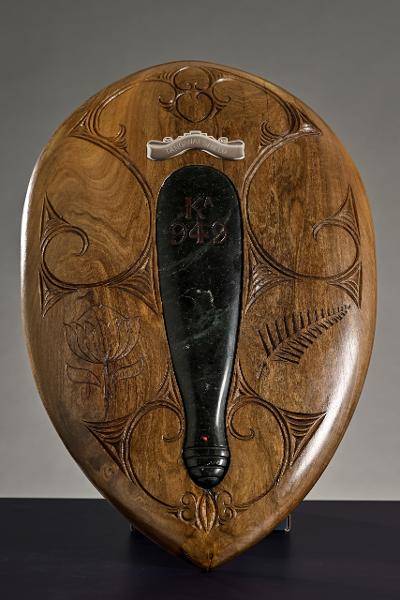Tangiwai Shield to be unveiled
Saturday 3 February 2024, 4:24AM
311 views

The most poignant chapter in the long history of New Zealand and South African cricket is to be officially recognised with the unveiling of the Tangiwai Shield.
Ahead of the opening Test between the BLACKCAPS and the Proteas, the teams will play for a Series trophy that commemorates the tragic events of 70 years ago, when 151 people on the overnight express from Wellington to Auckland on Christmas Eve – including Nerissa Love, the fiancée of New Zealand fast-bowler Bob Blair, lost their lives in the country’s worst rail disaster.
The tragedy was particularly relevant to the New Zealand and South African teams of the day as it coincided with the second Test at Ellis Park, Johannesburg, where Blair was opening the bowling for his country.
Just 21, he was woken in the early hours of the second morning of the Test to be told he'd lost the love of his life.
He stayed at the hotel grieving as his team-mates resumed the match, with the flags of both countries lowered to half-mast.
Blair’s unexpected appearance out of the players’ tunnel after New Zealand lost its ninth wicket stunned the knowledgeable Ellis Park crowd into silence, and left players from both sides in tears.
Today, Blair’s story of tragedy and courage, and the manner in which the South African team, board and public rallied around to support him and his team-mates, remains one of the defining chapters of New Zealand sport.
The late, Christchurch-based cricket writer Dick Brittenden, whose reports from that Test rank amongst the finest New Zealand sports writing produced, said it was a story that every Kiwi child should learn at their mother’s knee.
The Shield, created by carver David Ngawati (Ngāti Hine), is made from New Zealand native timber puriri, and includes an inlaid mere made from pounamu sourced from the Tangiwai region.
It will be blessed and presented to the teams in Tauranga.
Blair now lives in Cheshire, UK, with his wife Barbara, and is the only surviving player from the Test.
The events of that week have since inspired hundreds of articles, many books – several authored by South African scribes, some by New Zealanders; a TV film produced in New Zealand, and a play called “The Second Test”.
NZC chief executive Scott Weenink said the Shield was a fitting acknowledgement of what he considered one of the great stories of Kiwi sporting courage.
“The background to this Test match is one of the most sad and moving and heart-breaking stories imaginable,” he said.
“It’s also an uplifting story of incredible courage and resilience, and in terms of the South African team and public, great compassion and empathy.
“I’m delighted to see this very important part of cricket history properly recognised and acknowledged.”
Cricket South Africa chief executive Pholetsi Moseki welcomed the initiative.
“On behalf of CSA, I send my best wishes to everyone who was touched by this tragedy, and to both teams contesting the inaugural trophy.
“It‘s important that the teams of today and tomorrow know where they came from, and I’m sure the Tangiwai Shield will do much to assist with that.”
The Tangiwai Test
A synopsis of the story behind what is now known as the “Tangiwai Test” can be found below.
The first match of the Tegel Test series starts on Sunday, at Bay Oval.
On the second day, the New Zealand team left for the ground without Bob Blair – who stayed behind at the hotel, understandably distraught.
After dismissing the hosts, the New Zealand team’s batting was then cut to pieces by South African fast bowler Neil Adcock, who sent two batsmen, including the great Bert Sutcliffe, to hospital.
Incoming batsmen had to scratch their guard on a blood-soaked crease.
Everyone was hit.
Sutcliffe was hit above the ear fourth ball and went down unconscious. Lawrie Miller was struck over the heart and rushed to hospital, coughing blood. John Reid was black and blue, Frank Mooney was peppered.
Poor Johnny Beck. He was hit in the groin so hard by a delivery from Adcock that his box was inverted.
South African Jackie McGlew hammered it back into shape with the handle of his bat.
Sutcliffe, his head swathed in bandages, later returned to launch a late assault on the bowling but, when the ninth wicket fell, started walking off the field to a tumultuous ovation.
It’s then that it happened.
As Sutcliffe was being loudly and generously cheered off the field by the Ellis Park crowd, Blair appeared out of the players’ tunnel, padded up and ready to bat.
When Sutcliffe asked, “what are you doing here, Bob?” he replied, “I just wanted to help.”
The Ellis Park crowd immediately fell silent at his appearance, standing as one, mute in its respect, as the pair walked back to the pitch arm-in-arm, while team-mates and opponents alike shed tears.
When asked later how quiet it was, Sutcliffe said, “you could’ve heard a pin drop, son”.
Sutcliffe and Blair then proceeded put on a rapid 33, including a world record of 25 off one Hugh Tayfield over.
When they walked from the field shortly after, following Blair’s dismissal, the Ellis Park crowd gave them a thunderous ovation.
South Africa ended up winning the Test comfortably.
For Blair, the rest of the tour was a nightmare.
There was no overseas air passage available in those days and the voyage by sea took 28 days – far too long for him to return for his fiancée’s funeral.
To make things worse, the letters Nerissa had written and posted to him daily from New Zealand, continued to arrive throughout the tour.